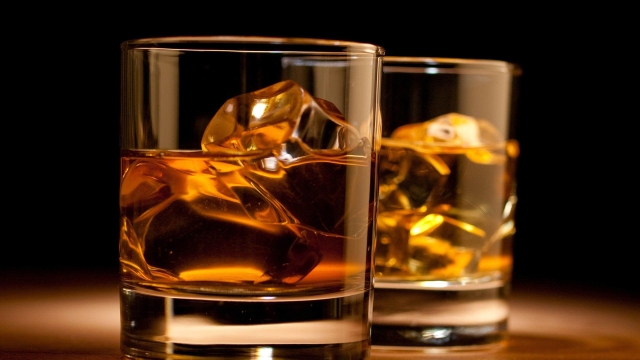Whisky, with its enticing aroma and rich flavors, has captivated the hearts of connoisseurs and casual drinkers alike. This magnificent spirit, often referred to as the "water of life," holds its own unique place in the realm of libations. From the moment the golden liquid cascades into a glass, each sip offers a journey into a world brimming with history, craftsmanship, and undeniable allure.
Distilled from grains and aged in oak barrels, whisky possesses a complexity that is unmatched. Its origins can be traced back centuries, weaving tales of ancient distilleries shrouded in mystery and tradition. Whether it hails from the rolling hills of Scotland, the rugged terrains of Ireland, or the vast wilderness of America, each whisky region boasts its own distinctive production methods, resulting in an array of mesmerizing whisky styles to explore.
As one indulges in the enchanting world of whisky, a symphony of flavors dances upon the palate. From the smooth and silky notes of caramel and vanilla in bourbon, to the smoky peatiness of Islay single malts, every sip tells a story. Beyond the flavors, however, lies the allure of whisky as a conduit for connection and celebration. It has the power to bring people together, sparking conversations and forging unforgettable memories.
So, join us on a journey to lift the spirits and delve into the captivating world of whisky. With each article, we will uncover the secrets behind its production, explore the diverse range of whisky styles, and provide guidance on how to appreciate this glorious beverage. Whether you are a seasoned whisky enthusiast or just beginning to discover its magic, prepare to embark on an extraordinary adventure that will leave you craving the next pour.
Whisky Ingredients and Production Process
Whisky, often associated with elegance and sophistication, is a beloved spirit enjoyed by many around the world. Crafted with utmost care, whisky undergoes a meticulous production process that results in its distinctive flavors and aromas. Let’s delve into the fascinating world of whisky and explore its key ingredients and the intricate process behind its creation.
The journey begins with the selection of quality grains, primarily barley, corn, rye, or wheat, which form the foundation of whisky. Depending on the type of whisky desired, these grains are carefully chosen to impart specific flavors and characteristics. The choice of grains plays a crucial role in defining the final product, with each type bringing its own unique attributes to the spirit.
Once the grains are selected, they are subjected to malting, a process in which they are soaked in water and allowed to germinate. This activates enzymes within the grains, converting starches into fermentable sugars. The malted grains are then dried in kilns, halting germination and preserving the flavors developed during the malting process.
Next comes the mashing stage, where the malted grains are ground into a coarse flour called grist. This grist is mixed with hot water in a vessel called a mash tun, facilitating the extraction of sugars. Through careful temperature control, enzymes present in the grains convert the starches into fermentable sugars. The resulting liquid, known as wort, is rich in sugars and ready for fermentation.
Fermentation, a critical step in whisky production, involves the introduction of yeast to the wort. This yeast consumes the sugars present, converting them into alcohol and producing a myriad of flavor compounds. The fermentation process may take a few days to a week, during which time the yeast works its magic, infusing the liquid with its distinct character.
In the subsequent stages of distillation and maturation, which we will explore in the following sections, the fermented liquid transforms into whisky, acquiring complexity and depth over time.
The production process of whisky involves a delicate interplay of ingredients and methods to create a drink that captivates the senses and lifts the spirits of those who savor its exquisite flavors. Now that we understand the role of key ingredients and early production steps, we can delve deeper into the intriguing journey of whisky.
The Diversity of Whisky Styles
Whisky is a drink that comes in a fascinating array of styles that cater to a variety of tastes and preferences. From bold and smoky to smooth and fruity, there is a whisky style out there for everyone to enjoy.
Scotch Whisky: As one of the most popular styles of whisky, Scotch whisky is often characterized by its rich and complex flavors. It is made primarily in Scotland using malted barley and aged in oak barrels. The flavors can range from peaty and smoky in the case of Islay whiskies, to light and delicate in the case of Speyside whiskies.
Bourbon Whiskey: Hailing from the United States, bourbon is a whisky style that is known for its sweetness and robust flavors. It is made mainly from corn and aged in new charred oak barrels, giving it a distinct caramel and vanilla taste. Bourbon whiskey is often enjoyed straight or used as the base for classic cocktails like the Old Fashioned or Mint Julep.
Irish Whiskey: Irish whiskey is renowned for its smoothness and lightness. Made primarily in Ireland, it is typically triple distilled and made from a mixture of malted and unmalted barley. The resulting whiskey is characterized by its gentle flavors of honey, vanilla, and citrus, making it an easy-drinking and approachable option for whisky enthusiasts.
Each whisky style holds its own unique character and charm, allowing drinkers to embark on a delightful journey of discovery. Whether you prefer the peaty smokiness of a Scotch whisky or the smooth sweetness of a bourbon, there is a whisky style out there that is sure to captivate your taste buds. So, raise a glass and delve into the enchanting world of whisky, where diversity reigns supreme.
Appreciating and Tasting Whisky
In order to fully appreciate the nuances and flavors of whisky, it is important to approach the tasting process with a keen eye and an open mind. Whether you are a seasoned whisky connoisseur or a newcomer to the world of this illustrious spirit, there are a few key steps to follow in order to truly savor the experience.
First and foremost, take a moment to examine the whisky’s appearance. Observe the color and clarity of the liquid in your glass. From a pale golden hue to a rich amber or even deep mahogany, each shade can offer insight into the age and maturation of the whisky. Take note of any variations or patterns in color, as they may indicate unique characteristics.
Hibiki Whiskey
Next, bring the glass to your nose and inhale gently. Take in the aromas that dance within. Pay attention to the distinct notes of vanilla, caramel, fruit, or even peat smoke that may greet your senses. Allow yourself to delve deeper into the layers of scents, as they can provide clues to the whisky’s origins and production methods.
Now, it is time to finally taste the whisky. Take a small sip, allowing the liquid to coat your palate. Pay attention to the flavors that emerge. Is it smooth and sweet, or robust and smoky? Are there hints of spice, dried fruits, or perhaps a touch of oak? Allow the flavors to unfold on your tongue, taking your time to savor the complexity and craftsmanship that went into creating this fine spirit.
Remember, there are no right or wrong answers when it comes to tasting whisky. Each individual brings their own unique palate and preferences to the table. The journey of appreciating and tasting whisky is a personal one, filled with discovery and delight. So, raise your glass, take a moment to truly savor the experience, and let the enchanting world of whisky captivate your senses.






